Software Series 60 2nd Edition>>>
Now we can observe the passage from the second edition of the platform 60 to its third version, and that means not only a smooth improvement of characteristics of the operating system, but the change if its version, and as a result a partial incompatibility with programs developed for the previous models. The majority of old system programs can run on devices using platform 60 third edition, however they can't use all capabilities of the system provided by various API. Such programs are stretched for the screen's resolution, which grew to at least QVGA. And from esthetical point of view, their appearance really suffers a great deal. The majority of games and other applications using system capabilities of Series 60 Edition 2 won't work on new devices, and that is the pay for a grown functionality.
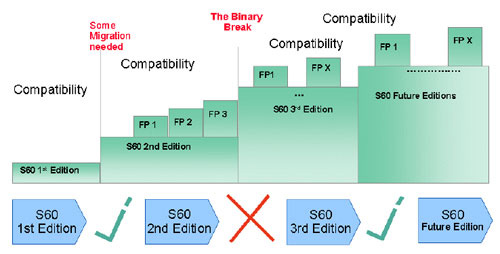

The third edition applies Symbian 9.1 as a version of operating system, the kernel of which is completely redeveloped. And it is run in real time - EKA2. That allows making applications, which are crucial to run time, for instance, VoIP.
Developers will find it interesting to know about a new compiler used and improvements regarding security capabilities. In particular, an idea of certified applications is being brought, which will have access to some APIs, and the company opened many of them (about 40 APIs are now available, which allows developing any type of application). We won't list all APIs here and will highlight only the most interesting ones. People uninterested in cobwebs of the operating system and applying only a user part of the interface can surely skip this paragraph and pass to the last part of the material.
New APIs and functions in 3rd Edition
Installation - despite the .SIS file extension is preserved, only SISX applications can be installed (that is an extended format of installation files).
New data keep model. By default applications can access memory of the device and folders marked as open for various operations. Others can be addressed corresponding with the certificates correlating with the program. This is the first time the Central Repository of data appears, all settings and application data are stored there. You can compare this with a Windows registry, they are similar. The repository keeps data permanent for all applications; all variables kept in RAM refer to Publish&Subscribe API (it was introduced in 2nd FP2, Symbian 8.0). And correspondingly APIs used for the same purposes (System Agent, Shared Data) were withdrawn.
Light API - allows control over the keypad and screen backlighting from applications.
Vibra API - expanded control over a vibracall, during games and application work. It replaces Vibra Control API. Also Vibra Settings API which allows change settings present.
HWRM Power State API - information about the battery level and current status. It allows creating a corresponding function in applications easily, for instance, in shell analogs widely available for Windows Mobile devices.
Profiles Engine Active Profile Settings API - contains data about an active profile (for example, sound level, and call type selected for voice calls or SMS alert).
Find Item API - allows marking out numbers, e-mail addresses and links in text.
Startup List Management API - is a capability for developers to add their applications to the list of programs automatically starting up with the device.
PtiEngine API - low-level access to text input functions, using predictive input. In perspective, that means that third-party applications support the same input methods that the original shipment applies.
Common Audio Enhancements API - defines an interface used by audio applications.
OMA DRM v2.0 - the passage to the second version of control over digital rights for content, brings strengthening of the control, fully compatible with the first version.
DRM Audio Player API - allows playing protected content in applications equipped with a DRM functionality, only files saved on the device can be played (no capability to play threads).
Exif API - represents information about the headings of JPEG files (time of creation, change, and reading).
MIDI client API - integrates work with MIDI into third party applications (Symbian version 8.0).
Audio Effects API - allows access to equalizer settings, selecting them, access to various sound effects, including Stereo Widening. Audio Effects Preset API is responsible for setting of effects and equalizer.
Network Status API - shows data about the current network condition.
Location API is a set of 7 various APIs which allows working with GPS-devices (both external receivers and integrated ones). Routes and anchor points are supported.
Scalable 2D Vector Graphics API (JSR-226) - view SVG-files, which is a 2D vector graphics, can be used in various applications, for instance, showing cartographic information.
New programs in a standard package
Flash Lite Viewer 1.1 - an application which allows viewing SWF files on a smartphone, preset. Can be available for some products based on FP3

Download manager is a separate application associated with a browser (is called from the browser by clicking corresponding links). It can show information about an object (file type, size), ask for confirmation for download. Downloads files unsupported by the device by request (user dialog), they are saved on external memory cards and can later be transferred to PCs and other devices. You can use quick launch of applications to view files of supported types. The applications start in background and only one file per a time unit is available. A user can interrupt load and then starts from the same moment (depends on the type of the server).
A buffer located in RAM is used at loading multimedia files or maybe other file types unsupported by the browser. Its size is equal to the file size. The number of run applications influences memory value and can result in impossibility to load a file, then we recommend to close all applications. You can't upload files more than the RAM size (excluding supported file types not passed to third party applications).
Hardware changes supported on the level of operating system
Support for Bluetooth version 1.2, and added Remote SIM Access profile (necessary for full work of speakerphone car kits).
Support for WLAN (WiFi).
Support for SD, miniSD cards.
Support for QWERTY-keypads.
You should remember that manufacturer can refuse integrating memory cards, Wi-Fi adapters and so on. Nevertheless these options are supported on the OS level.
User program set in Series 60 3rd Edition
Before passing to detailed discussion of software functions, we should note that some devices can have no these or those capabilities (for instance, voice dial). That is why be careful, and read smartphone specifications in a corresponding section.
At first sight, the interface differs from the previous version in nothing. The ideology was preserved, though the functionality expanded, which couldn't but influence the comfort in use. In particular, a blue icon appears in all menus (a blue round), which symbolizes a running application. In the main menu you will see that sections with running applications are marked with this icon. You can access them by holding the Menu button.
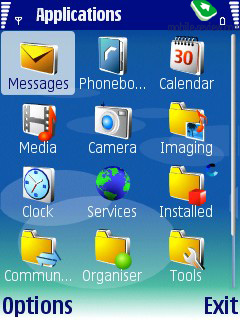
Similarly to the second edition, themes are supported, battery level icons are three-dimensional. Time and date are shown on the screen in the standby mode. A small status bar in the top right corner, it shows icons of current events, for instance, active Bluetooth. This line is seen even after an application is started, the majority of applications do now close it.
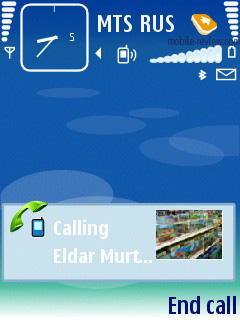
You can use a joystick and soft-keys for navigation. All keys allow assigning various functions different from presets. The menu button provides access to the main menu, if holding it, you will have a list of running applications, which are kept in memory. Pressing C in this list, you free your memory by closing a selected application.
Any menu can be shown either as a set of icons or a list. That's up to you which type to select.

You can switch memory types if you are allowed to view files from various places (card or phone) in an application.
You can activate Active Standby in the standby mode. Then the main screen provides a short report on all received messages and a line with tags for fast launch. That is a copy of Today screen in Windows devices.
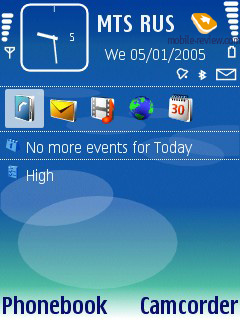
The most important changes in software are a section for working with a GPS-receiver (both internal and external), support for SVG files, and a Flash Player. The browser provides with a standalone download manager (read about it above). Voice recognition system independent of a speaker's voice is also worth attention (it works with phonebook contacts). Other improvements are less significant, and really carry out nominal value. In particular, a set of new templates and improvements in text input for MMS message appeared.
Contacts The phonebook allows almost any number of entries, and only total memory size is a restriction. You can store Name, Surname (two lines), Company name, Position, phone number, Mobile phone, Fax and E-mail address for a name. If this number of fields is small for you, add any number from the menu (including postal address, e-mail address and so on). You can enter a long text note for a name; assign a photo to show at incoming calls (not full-screen). And finally, any field can be renamed, for instance, you can rename Position into Birth Date. Search for a name in a phonebook is not limited to one letter. And an icon of a photo assigned is shown in a general list.
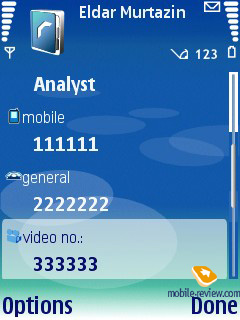

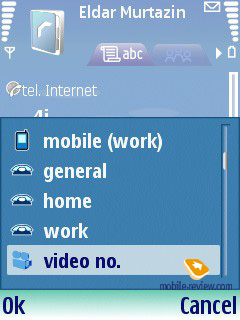
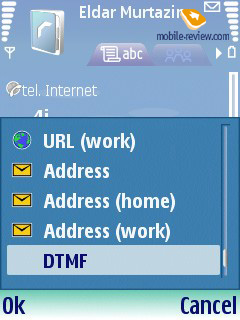
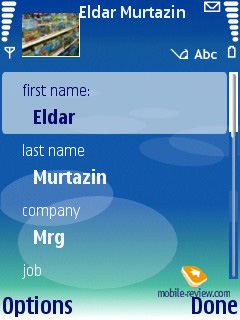
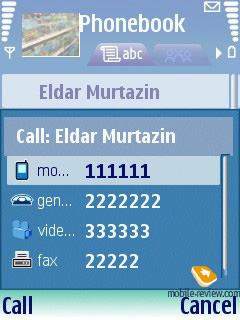
Users' groups allow assigning a group signal. And one user can belong to several groups. You can select either all entries in any list (contacts, message list) or tip necessary ones.
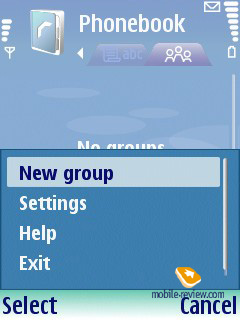

Voice recognition requires no preliminary training, and names entered in English are automatically tuned to fit an average value (recognition works for other languages). You can switch on system training and adjust voice dial for a speaker's voice.
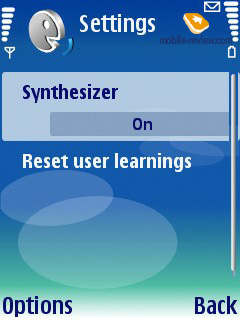
Now you can duplicate a contact, create a copy of an existing entry in the phonebook.
Call Log. This menu provides access to lists of missed, received and made calls, and by the way, you set a time period for storing data by yourself (that is a month by default). Call type (voice, data), duration, date, time and certainly a number if determined are specified for each call. A convenient function for call filtering by type (data, GPRS, voice, incoming, outgoing, message). Here call duration and cost is calculated. By the way, call duration is shown on the screen during a conversation.

Messaging. You can create MMS besides standard short messages; also send/receive your mail (POP3/IMAP4/SMTP/MIME2). Own templates can be created for any message, and 10 preset ones are available for SMS.
.
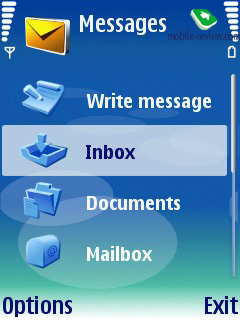
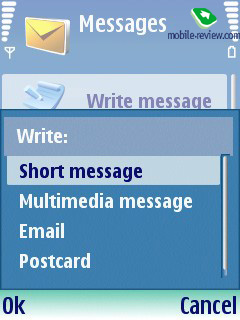
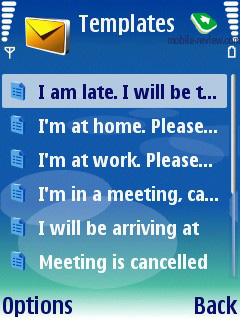
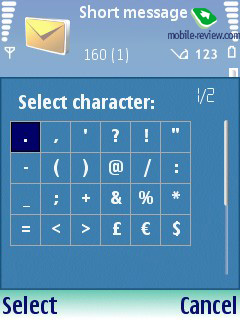
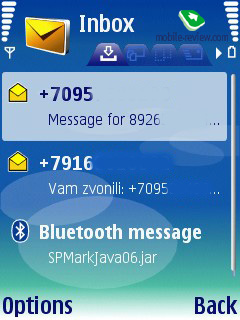
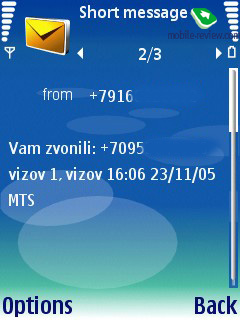
When creating an MMS and e-mail messages, you can select whether to show fields like Subject, Cc and Bcc (for each field) or not. A priority field also appeared - Low, Normal, and High. An important improvement is now a capability to add attachments of any format, even not supported by the device. You can use automatic monitor of up to two boxes in order to check new mail, request interval can be set (day, time). Also you can specify if a full letter will be automatically downloaded, or only a pert of it (a limitation to several KB), or a header only. Push Mail is supported (only using IMAP IDLE).
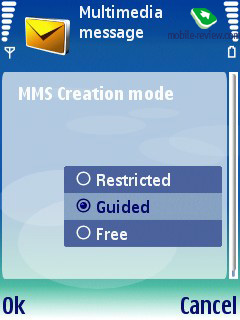
Now a capability to calculate the number of remained characters in a current message in run time mode (and before it was not calculated instantly). The calculation is based on a selected encoding table.
For the first time WCDMA Cell Broadcast (CBS) messages are received.
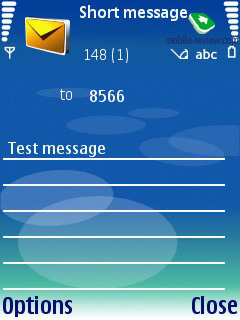
An MMS section was developed greatly, BCC and CC copies were added, and a priority field as well. In addition to usual delivery reports, you can see status for certain addresses (Delivery Reports folder). Icons identify a message status in a list of sent messages (received or not). Also an expanded set of icons signaling a message status (it is turned off by default, however is present in the operating system).
MMS Postcard client - this is a regular step to simplifying MMS service, only one template is created from the beginning here, room for a photo or a picture is to the left, text and address fields are to the right. The developers think that a format of a post card is ideal for messages, which will later be printed.
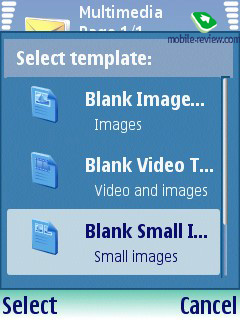
MMS Upload. You can create up to 4 accounts for this service. You can select files to upload to a remote server automatically from the gallery or image and camera view modes (a picture is automatically scaled, images are sent one by one if several ones are selected). Also a file name serves a header at sending.
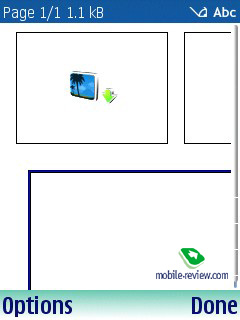
MMS Presentation (3GPP SMIL). You can create animated presentations of various type and size. Any graphics and video can be used there; you can combine elements on the screen in arbitrary order. Preset templates of such messages are present in the device. Such presentations are received only by several smartphones mainly Nokia's.
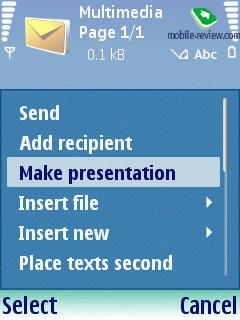
Created MMS can be stored on external memory cards, and this capability was absent before (for the first time is appeared in 2nd Edition FP3).
A folder Incoming contains all messages received by the device (a joint list), and also files received from other devices via Bluetooth or IrDA (if present).
Calendar. Several versions of calendar view are foreseen - a monthly (a corner is marked for a sate with set events), a weekly (with days divided by hours), and daily (hour division also). Only three event types are supported - Meeting, Memo and Anniversary. Alert can be tuned for each of them. And that is all for organizer capabilities - no settings or means for working with events including viewing all entries. So, you see, the organizer is quite ascetic, however many people still will be pleased with its capabilities.



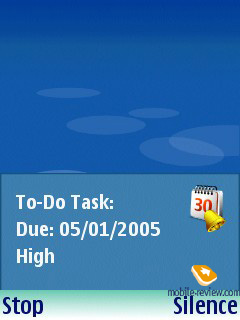
Gallery. All user files are kept here; they are divided into corresponding groups - Pictures, Clips, Sound files. You can use either phone memory or internal one. From here it is possible to send files to other devices, attach to an MMS or e-mail, and print (sending via Bluetooth).

Profiles. You can create own profiles from the very beginning, and that seems an advantage.

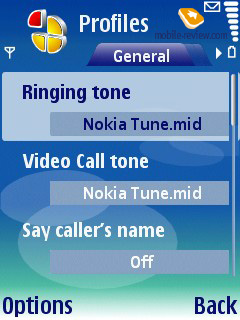
Favourites. You can create a tag for almost any file (note, image, sound) and it will be placed into Favourites automatically. Sometimes the function can be very helpful.
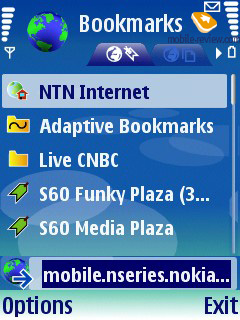
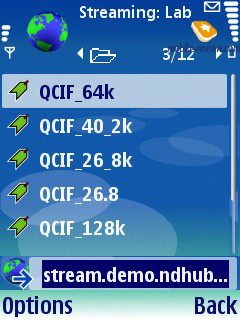
To-do. A usual to-do list, where you can set time and date, set one of three priorities and a done mark.

Connectivity. Here are all settings concerning connections, even modem settings and Bluetooth. A real minus is absent Bluetooth indicator on the body, the developers thought that users will either apply Bluetooth function permanently or won't start it at all.

PTT - Push to Talk, the settings are ordinary and represent nothing interesting. You can see all names from the contact list with entered PTT address, create own groups and new names.
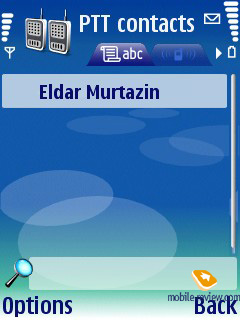
IrDA (if present) - activate or deactivate.
Bluetooth - version 1.2 is supported, SIM Access Profile is present, however sometimes sound is not transferred to a stereo headset (check profiles of actual devices, the support is specific).
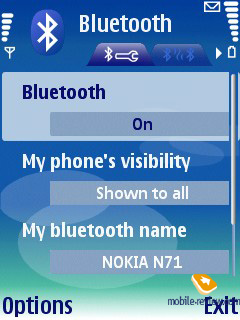
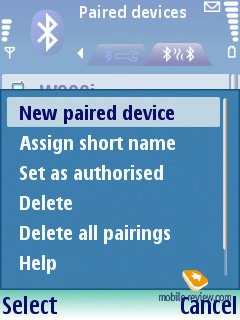
Connection Manager - this manager shows all connections active for the moment, there you can switch a selected connection off.
Sync - combines settings for synchronization with PC (possible to use a cable, IrDA, Bluetooth) and corresponding software on PC, and settings to access LifeBlog (a server where you can keep your blog with text notes, photos and so on).
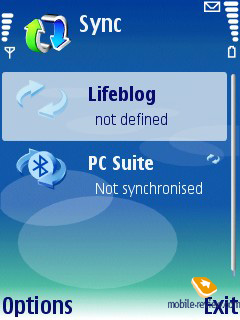
USB 2.0 is supported, at that you can select behaviour for a device, four variants are available (ask user, PC Suite, File transfer, PictBridge).
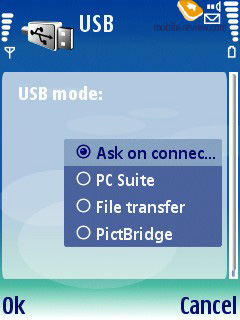
Extras. This menu provides access to several applications at the same time - notes, plain text files (which are created by a user), quite a nice and convenient calculator, converter and clock. The last item includes alarm clock settings, which is quite plain - once, no recurrent events, days and other trifles - minimalism everywhere.

A dictaphone allows recording about a minute of sound.
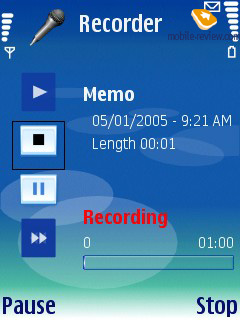
Wallet. This application is absent and is not shipped with phones on Series 60 3rd Edition.
Themes. You can change not only screen saver, but sounds and icons in a single place. That is all done in one touch. And several themes are present in a model as a rule.
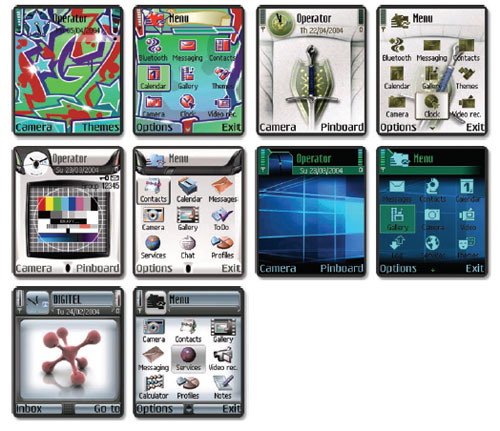
RealPlayer is a standard application for playing multimedia files, the capabilities aer ordinary and will please the majority of users. The player supports play lists (mp3 or mp4 files), allows sending them to other devices via bluetooth. A play list format is M3U. Multimedia Framework supports two new codes - AAC+, eAAC+. And here is a full list of supported formats - WMA, RealAudio Voice, RealAudio7, RealAudio8, MP3, AAC, Real Audio, WAV, Nokia Ring Tones, AMR, AMR-WB, AMR-NB, AU, MIDI, H.263, JPEG, JPEG2000, EXIF 2.2, GIF 87/89, PNG, BMP (W-BMP), MBM, MPEG-4 and eAAC+. You can select any of preset equalizers or create own.

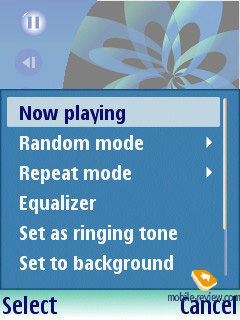

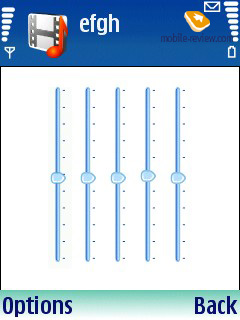
Video is played full-screen.
Internet. Here is a browser, which allows viewing usual network recourses, a bookmark manager is present. It is renamed to Adaptive Bookmarks. If you visit recourse, its address appears in a list of these bookmarks. And the more frequent you appeal to this recourse, the higher in the list it is placed. That is some kind of History, which allows calling necessary sites fast.
The browser can work full-screen; address line can be filled automatically (if you have already entered this address). In its capabilities a browser loses to a mobile version of Opera in no way. MiniMap should be mentioned as an unordinary function. Imagine that you start viewing a page without stretching into a single line (as a rule that means a horizontal scroll bar), when you scroll in any direction - a semitransparent model of the site appears on the screen, and a currently shown object is highlighted. The function is interesting and original, however brings no real improvements to a user as doesn't prevent four dimensional scrolling. That is a pleasant trifle, not more. And here is a list of claimed browser changes:
· - Original page design is preserved, no distortions;
· - Pop-up window block, plainer menu and improved start page;
· - Visual history: visited before pages are marked with thumbs;
· - Plain text search within a page;
· - Support for RSS;
· - Support for Dynamic HTML (DHTML);
· - Support for the main W3C standards.
The browser is an Open Source development. And the company of Nokia opened its portal opensource.nokia.com officially to support open source developments. The browser is built on Safari Web Kit by Apple. And you can see the interface example and the way the browser works - (http://www.s60.com/browser).
Settings. Besides menu language, you can specify language for text input. Items assigned to joystick deviations and soft-keys are adjustable. Screen settings as brightness and selection of backlighting time are present.
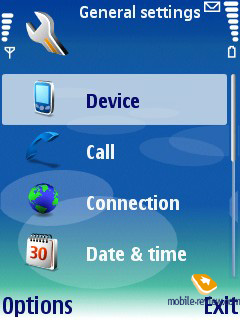

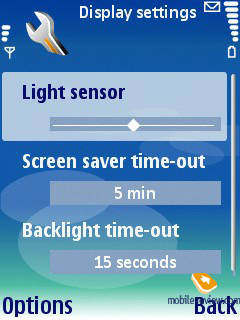
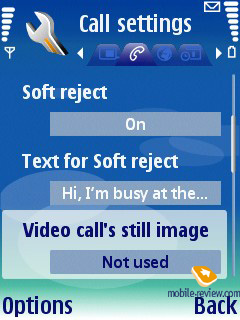
GPRS settings, security ones, time and date, and automatic lock.
Tools. Profiles allow changing the phone's behaviour depending on your needs; in particular, change a call melody, its volume, and other sound settings.

Application manager allows setting or deleting applications from the phone's memory or a memory card.

Fast dial - you can set numbers for fast dial here.
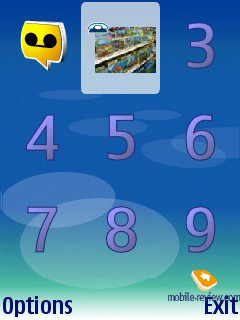
Voice commands. Sets commands for some menu items, preliminary training is not required.

File manager is a plain manager, which allows copying, deleting and moving files both in the internal memory and memory card.
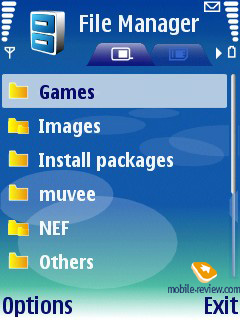
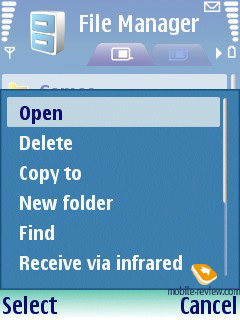
Device manager -SyncML synchronization.
Memory - you can view the condition of your card and free space.

Chat - An application for instant messages exchange.
Data Transfer. This application allows transferring a phonebook, a calendar and some other entries from other Nokia's phones to these devices, which is a good application for migrating to another phone without data loss. This will suit people, who do not use a desktop PC for this purpose.

Active Keys - represents a list of security keys necessary to access protected content.
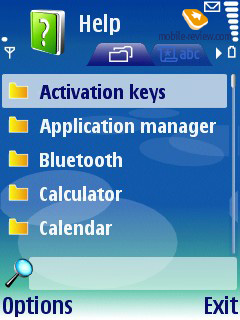
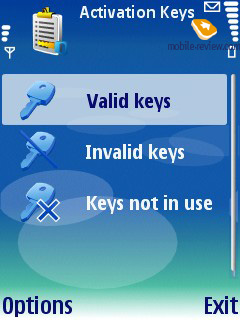
Tutorial is a manual for phone functions and use of various buttons, includes chapters and a video clip demonstrating the main operations in a visual manner.
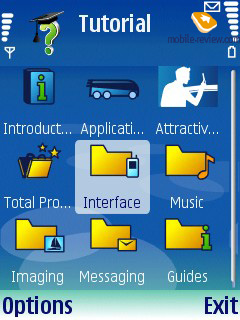
Visual Radio is network radio, which allows not only listening to music, but also viewing images concerning them on the screen.

FM radio may be present depending on a model, the interface is usual; you can save 20 stations under own names, no peculiarities in realization.
Location. Work with coordinates received either from network or from an external GPS-receiver. You can create routes, save them and set landmarks. A window where average speed and time remained to the set coordinates are detected.
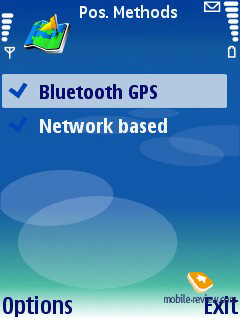
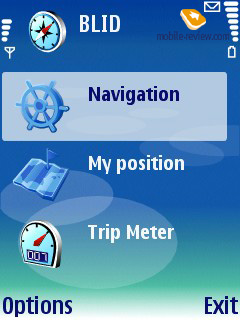
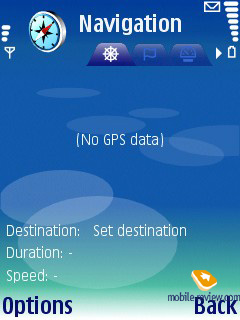
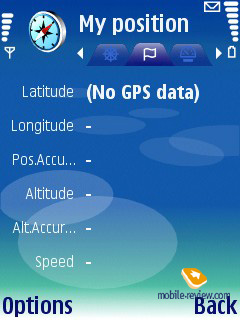

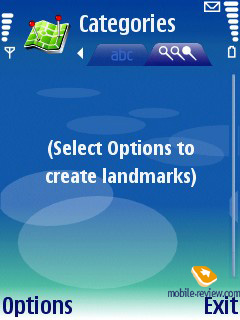
Short conclusion
The potential of Series 60 3rd Edition will be demanded at least in the course of two years and even more considering expansions for basic functions in Feature Packs. A capability to create one-chip models will allow reducing the price at the launch moment for smartphones dramatically, at the same time smartphones will preserve functionality due to standard schemes known even today.
The platform is called upon competing both with Windows Mobile devices and Symbian UIQ smartphones (3 version, the first representative is Sony Ericsson P990i). The company of Nokia has eased developers' lives to the maximum having opened access to APIs unavailable before. And if licensing, it allows creating very flexible (that is a curtsey against Windows Mobile, which allowed easier creation of new applications before). At the same time interface settings and basic functions are comparable with UIQ 3.0 (as for me, that is the most well-thought interface for today). Now Series 60 3rd Edition includes some trifles, which however prevent from calling this solution the best (for instance, no A2DP profile for bluetooth, a caller's icon is small). At the same time some of innovations make the phone very interesting (particularly, the new browser, which exceeds the current Opera version in functionality, expanded MMS and a well realized mail client). Due to mass application of Series 60 3rd Edition in various devices and creating smartphones in various form-factors, the company of Nokia will make this solution the main on the smartphone market. Or we can consider that Series 60 3rd Edition will be the core of the majority of modern smartphones of 2006-2007. And considering that Feature Packs appear very fast, we can surely expect that Feature Pack 2 will make this software the leader of the market.









































































